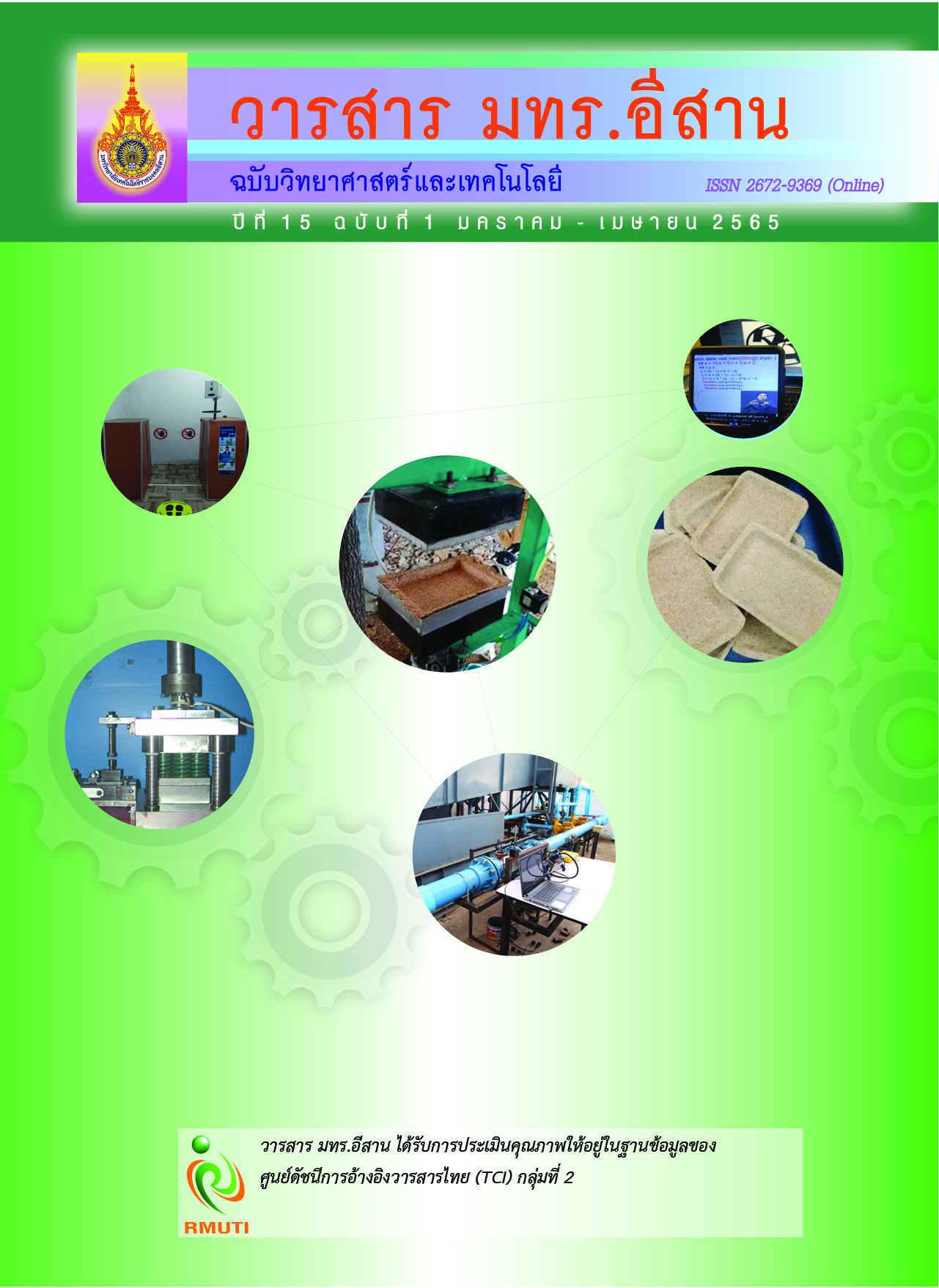Antioxidant Activities and Phenolic Acids Profile of Pasteurized Mulberry Juice During Storage
Main Article Content
Abstract
This study aimed to investigate changes in the bioactive compounds of mulberry juice by pasteurization treatments during 3 months of storage at 4±2 °C. The results of sensory evaluation, using a 9-point hedonic scale, showed that the highest color score, taste, odor, and overall appearance of mulberry juice (Buriram 60 containing 40 and 50 %, 13 oBrix) was statistically significant (p≤ 0.05). The effect of 3 months storage at temperatures of 4±2 °C on degradation of anthocyanin content, phenolic compounds and flavonoids in mulberry juice was determined. The total phenolic, flavonoids, anthocyanin content decreased by 55.57, 55.16, and 65.64 %, respectively. The losses of antioxidant activity in mulberry juice during storage determined by FRAP and ABTS were 34.18 and 65.91 %, respectively. The mulberry juice samples were analyzed by Ultra-performance liquid chromatography (UPLC) with a diode-array detector to identify the polyphenols. The UPLC detected a decrease in gallic acid, hydroxy-benzoic acid, vanillic acid, trans-ferulic acid, rutin, and sinapic acid (97.67, 94.61, 78.33, 96.99, 53, and 29.13 %, respectively) (p≤ 0.05). This study could be applied as a guide to improving the bioactive compound stability and antioxidant activity of mulberry juice, thereby improving and promoting the development of the mulberry juice processing industry.
Article Details

This work is licensed under a Creative Commons Attribution-NonCommercial-NoDerivatives 4.0 International License.
References
Yuan, Q. and Zhao, L. (2017). The Mulberry (Morus alba L.). Fruit-A Review of Characteristic Components and Health Benefits. Journal of Agricultural and Food Chemistry. Vol. 65, No. 48, pp. 10383-10394. DOI: 10.1021/acs.jafc.7b03614
Ramesh, L., Sivaram, V., and Yogananda Murthy, V. N. (2014). Antioxidant and Medicinal Properties of Mulberry (Morus sp.): A Review. World Journal of Pharmaceutical Research. Vol. 3, Issue 6, pp. 320-343
Sanchez-Salcedo, E. M., Mena, P., García-Viguera, C., Martínez, J. J., and Hernández, F. (2015). Phytochemical Evaluation of White (Morus alba L.) and Black (Morus nigra L.) Mulberry Fruits, a Starting Point for the Assessment of Their Beneficial Properties. Journal of Functional Foods. Vol. 12, pp. 399-408. DOI: 10.1016/j.jff.2014.12.010
Du, Q., Zheng, J., and Xu, Y. (2008). Composition of Anthocyanins in Mulberry and Their Antioxidant Activity. Journal of Food Composition and Analysis. Vol. 21, Issue 5, pp. 390-395. DOI: 10.1016/j.jfca.2008.02.007
Punnongwa, W., Jumpamee, N., Sakunnamrat, K., Toomtong, P., Deungsri, K., and Moongnargm, A. (2013). Comparison of Important Chemical Composittions and Antioxidant Activities of Mulbeery Fruits Provided from Tree Varieties. RMUTI
Journal Science and Technology. Vol. 6, No. 2, pp. 69-81 (in Thai)
Song, W., Wang, H., Bucheli, P., Zhang, P. F., Wei, D. Z., and Lu, Y. H. (2009). Phytochemical Profiles of Different Mulberry (Morus sp.) Species from China. Journal of Agricultural and Food Chemistry. Vol. 57, pp. 9133-9140. DOI: 10.1021/jf9022228
Dincer, C., Tontulb, I., and Topuz, A. (2016). A Comparative Study of Black Mulberry Juice Concentrates by Thermal Evaporation and Osmotic Distillation as Influenced by Storage. Innovative Food Science & Emerging Technologies. Vol. 38, Part A, pp. 57-64. DOI: 10.1016/j.ifset.2016.09.012
Boranbayeva, T., Karadeniz, F., and Ylmaz, E. (2014). Effect of Storage on Anthocyanin Degradation in Black Mulberry Juice and Concentrates. Food and Bioprocess Technology. Vol. 7, No. 7, pp. 1894-1902. DOI: 10.1007/s11947-014-1296-8
Huang, H., Ting-Tsz Ou, and Wang, C.J. (2013). Mulberry ( Sang Shèn Zǐ) and its Bioactive Compounds, the Chemoprevention Effects and Molecular Mechanisms In Vitro and In Vivo. Journal of Traditional and Complementary Medicine. Vol. 3, Issue 1, pp. 7-15. DOI: 10.4103/2225-4110.106535
Sinha, N. K., Sidhu, J. S., Barta, J. Wu, J. S. B., and Cano, M. P. (2012). Handbook of Fruits and Fruit Processing. (2th). New York: Wiley-Blackwell A John Wiley & Sons, Ltd, Publication
Zou, H., Lin, T., Bi, X., Zhao, L., Wang, Y., and Liao, X. (2016). Comparison of High Hydrostatic Pressure, High-Pressure Carbon Dioxide and High-Temperature Short-Time Processing on Quality of Mulberry Juice. Food Bioprocess Technology. Vol. 9, No. 2, pp. 217-231. DOI: 10.1007/s11947-015-1606-9
You, Y., Han, N. X., Guo, J. L., Zhao, Y., Liu, G., Huang, W., and Zhan, J. (2018). Influence of Different Sterilization Treatments on the Color and Anthocyanin Contents of Mulberry Juice During Refrigerated Storage. Innovative Food Science and Emerging Technologies. Vol. 48, pp. 1-10. DOI: 10.1016/j.ifset.2018.05.007
Fellow, P. J. (2009). Food Processing. (3th). New York: CRC Press Taylor & Francis Group
Anprung, P. (2004). Principle of Sensory Evaluation. Chulalongkorn University (in Thai)
Wanyo, P., Meeso. N., and Siriamornpun, S. (2014). Effects of Different Treatments on the Antioxidant Properties and Phenolic Compounds of Rice Bran and Rice Husk. Journal of Agricultural and Food Chemistry. Vol. 157, pp. 457-463. DOI: 10.1016/j.foodchem.2014.02.061
Yodmanee, S., Karrila, T. T., and Pakdeechanuan, P. (2011). Physical, Chemical and Antioxidant Properties of Pigmented Rice Grown in Southern Thailand. International Food Research Journal. Vol. 18, No. 3, pp. 901-906
AOAC. (2005). Offical Methods of Analysis. (14 th ed). Washington, D.C: Association of official Analytical Analytical Chemist
Thaipong, K., Boonprakob, U., Crosby, K., Cisneros-Zevallos, L., and Hawkins, D. (2006). Comparison of ABTS, DPPH, FRAP, and ORAC Assays for Estimating Antioxidant Activity from Guava Fruit Extracts. Journal of Food Composition and Analysis. Vol. 19, Issue 6-7, pp. 669-675. DOI: 10.1016/j.jfca.2006.01.003
Vichapong, J., Sookserm, M., Srijesdaruk, V., Swatsitang, P., and Srijaranai, S. (2010). High Performance Liquid Chromatographic Analysis of Phenolic Compounds and Their Antioxidant Activities in Rice Varieties. LWT - Food Science and Technology. Vol. 43, Issue 9, pp. 1325-1330. DOI: 10.1016/j.lwt.2010.05.007
Tomas, M., Toydemir, G., Boyacioglu, D., Hall, R., Beekwilder, J., and Capanoglu, E. (2015). The Effects of Juice Processing on Black Mulberry Antioxidants. Food Chemistry. Vol. 186, pp. 277-284. DOI: 10.1016/j.foodchem.2014.11.151
Aramwit, P., Bang, N., and Srichana, T. (2010). The Properties and Stability of Anthocyanins in Mulberry Fruits. Food Research International. Vol. 43, Issue 4, pp. 1093-1097. DOI: 10.1016/j.foodres.2010.01.022
Wang, Z., Lin, Y., Li, T., Dai, F., Luo, G., Xiao, G., and Tang, C. (2019). Phenolic Profiles and Antioxidant Capacities of Mulberry (Morus atropurpurea Roxb.) Juices from Different Cultivars. International Journal of Food Properties. Vol. 22, Issue 1, pp. 1340-1352. DOI: 10.1080/10942912.2019.1646272
Shahidi, F. and Ambigaipalan, P. (2015). Phenolics and Polyphenolics in Foods, Beverages and Spices: Antioxidant Activity and Health Effects: A Review. Journal of Functional Foods. Vol. 18, Part B, pp. 820-897. DOI: 10.1016/j.jff.2015.06.018
Nguyen, C. L. and Nguyen, H. V. H. (2018). Ultrasonic Effects on the Quality of Mulberry Juice. Beverages. Vol. 4, Issue 3, pp. 1-12. DOI: 10.3390/beverages4030056
Kamiloglu, S., Serali, O., Unal, N., and Capanoglu, E. (2013). Antioxidant Activity and Polyphenol Composition of Black Mulberry (Morus nigra L.) Products. Journal of Berry Research. Vol. 3, No. 1, pp. 41-51. DOI: 10.3233/JBR-130045



